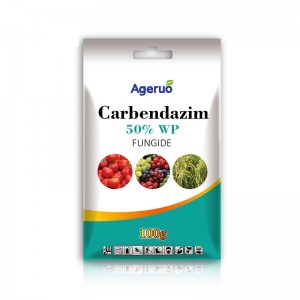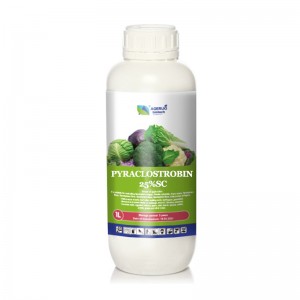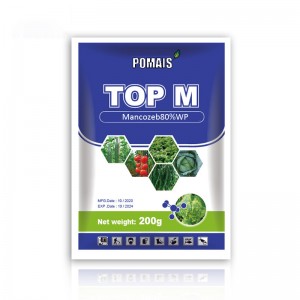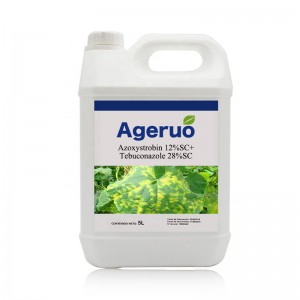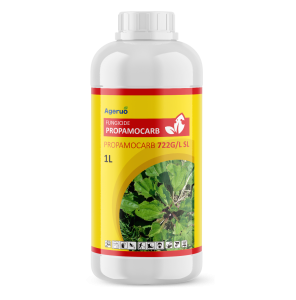Products
Pesticide Fungicide Propiconazole 250g/l + Cyproconazole 80g/l EC
Propiconazole + Cyproconazole
Related reading: Azoxystrobin and Propiconazole Fungicide Rotation
| Active ingredients | Propiconazole 250g/l + Cyproconazole 80g/l EC |
| CAS Number | 60207-90-1; 94361-06-5 |
| Molecular Formula | C15H18ClN3O; C15H17Cl2N3O2 |
| Classification | Fungicide |
| Brand Name | POMAIS |
| Shelf life | 2 Years |
| Purity | 33% |
| State | Liquid |
| Label | Customized |
Propiconazole 250g/L + Cyproconazole 80g/L EC is an advanced emulsifiable concentrate fungicide developed to provide broad-spectrum disease control in modern crop protection programs.
Both active ingredients belong to the Triazole chemical class and work systemically within the plant, delivering reliable results against a wide range of fungal pathogens.
Dual-Active Combination for Broader Spectrum
-
Propiconazole (250g/L) acts by inhibiting ergosterol biosynthesis in fungal cell membranes, disrupting cell development and reproduction.
-
Cyproconazole (80g/L) works through a similar mode of action but binds at slightly different sites in the fungal enzyme system, enhancing overall efficacy and delaying resistance development.
When used together, the two triazoles provide:
-
Strong protective, curative, and eradicant properties for existing infections and newly developing ones.
-
Broadened control spectrum, targeting multiple pathogens in one spray.
-
Better performance under fluctuating disease pressure compared to single active ingredient products.
Emulsifiable Concentrate (EC) Advantages
-
Easy to mix and maintain stable emulsification in the spray tank.
-
Ensures uniform spray droplet size, leading to better leaf coverage and absorption.
-
Facilitates quick uptake and upward translocation (acropetal movement) for protection throughout the plant canopy.
Physical & Storage Stability
-
Clear to slightly yellowish liquid, easy to handle and dose.
-
Stable for at least 2 years under recommended storage conditions.
-
Compatible with common adjuvants and fungicide partners for resistance management programs.
Where It Fits in the Field
Propiconazole 250g/L + Cyproconazole 80g/L EC is widely used in:
-
Cereal crops (wheat, barley) for rusts, leaf spots, and powdery mildew.
-
Fruit trees (apples, pears, citrus) for scab, powdery mildew, and other foliar diseases.
-
Grapes and vegetables where powdery mildew and leaf spots threaten crop health and market quality.
Its systemic action, combined with protective and curative properties, makes it an excellent fit for integrated spray programs where disease prevention and resistance management are priorities.
Mode of Action
Propiconazole 250g/L + Cyproconazole 80g/L EC works through a systemic, protective, curative, and eradicant mode of action.
Both active ingredients belong to the Triazole (DMI, Demethylation Inhibitor) class of fungicides, which act by interfering with the biosynthesis of ergosterol, a vital component of fungal cell membranes.
How Propiconazole Works
Propiconazole enters the plant tissues quickly after foliar application.
It moves primarily acropetally (upward through the xylem) to reach growing points where new infections are most likely to occur.
Inside the fungus, it blocks the demethylation step in sterol biosynthesis, leading to defective cell membranes.
This disruption halts the growth and spread of the pathogen, providing both curative and protective effects.
How Cyproconazole Works
Cyproconazole acts in a similar way but has slightly different binding affinity and activity spectrum compared to Propiconazole.
It also inhibits ergosterol synthesis, but due to its molecular structure, it can bind to alternative sites within the fungal enzyme system.
This subtle difference helps broaden the spectrum of control and slows down the development of resistant fungal strains.
Synergistic Performance
When combined, Propiconazole and Cyproconazole:
-
Deliver strong systemic movement within the plant, protecting treated foliage and new growth.
-
Provide overlapping but slightly different binding sites in the pathogen’s biochemical pathways, which enhances the overall fungicidal activity.
-
Reduce the risk of resistance buildup by requiring multiple mutation points for fungi to survive.
The result is a fungicide that not only controls current infections but also provides residual protection against reinfection during critical crop growth stages.
Key Takeaway
The dual-active Triazole EC formulation makes Propiconazole 250g/L + Cyproconazole 80g/L EC a flexible choice in integrated spray programs, suitable for crops facing high disease pressure from multiple fungal pathogens.


Target Diseases & Suitable Crops
Propiconazole 250g/L + Cyproconazole 80g/L EC is trusted for its broad-spectrum performance in controlling major fungal diseases across multiple high-value crops.
Its systemic, protective, and curative action makes it especially valuable during critical crop growth stages when disease pressure is high and yield potential is most at risk.
Common Fungal Diseases Controlled
This combination fungicide is highly effective against:
-
Rusts (Puccinia spp.) in wheat, barley, and other cereals.
-
Powdery Mildew (Erysiphe spp.) in grapes, fruit trees, and ornamental crops.
-
Leaf Spots (Septoria spp., Alternaria spp.) in cereals and vegetables.
-
Scab (Venturia spp.) in apples, pears, and stone fruits.
-
Other fungal pathogens sensitive to DMI fungicides, especially where curative and eradicant action is needed.
Suitable Crops
-
Cereal Crops: Wheat, barley, oats, rye, triticale.
-
Fruit Trees: Apples, pears, citrus, stone fruits.
-
Vineyards: Grapes (table and wine grapes).
-
Vegetables & Ornamentals: Various crops at risk of leaf spot and powdery mildew outbreaks.
Its versatility makes it an excellent fit for mixed-farming operations and diversified grower portfolios.
Typical Growing Regions & Conditions
-
Temperate Zones: Widely used in cereal belts with moderate to high humidity where rusts and leaf spots are prevalent.
-
Subtropical Fruit Regions: Effective in citrus groves, apple orchards, and grape vineyards where powdery mildew and scab are common threats.
-
Ornamental Nurseries: Employed in ornamental plant production to prevent powdery mildew and leaf spot diseases.
By targeting a wide range of fungal pathogens, this dual-triazole EC formulation reduces the need for multiple fungicide applications and helps growers implement more efficient integrated pest management programs.
Key takeaway:
With its broad crop adaptability and disease control spectrum, Propiconazole 250g/L + Cyproconazole 80g/L EC supports higher quality harvests and more predictable yields across diverse growing conditions.


Recommended Dosage & Application
To maximize the performance of Propiconazole 250g/L + Cyproconazole 80g/L EC, it is essential to apply the product at the correct crop growth stage and according to local disease pressure.
This dual-triazole fungicide is designed for foliar application only.
Standard Dosage Range
-
Cereals (Wheat, Barley, Rye, Oats):
0.5 – 1.0 L/ha, depending on disease severity and crop stage. -
Fruit Trees (Apples, Pears, Citrus):
0.5 – 0.75 L/ha per application. -
Grapes & Vineyards:
0.4 – 0.6 L/ha for powdery mildew and leaf spot control. -
Vegetables & Ornamentals:
Typically 0.5 – 0.8 L/ha, but always consult local guidelines and label recommendations.
When higher disease pressure is anticipated, or where weather conditions favor rapid disease spread, use the higher end of the dosage range for optimal protection.
Application Timing
-
Preventive and Early Curative:
Best results are achieved when applied preventively or at the very early stage of disease development. -
Repeat Applications:
Depending on disease pressure, repeat applications may be needed at 14–21 day intervals, but do not exceed the label’s maximum number of sprays per season. -
Resistance Rotation:
Rotate with fungicides from other mode-of-action groups to delay resistance build-up.
Spray Method & Best Practices
-
Use well-calibrated ground sprayers with flat-fan or hollow-cone nozzles to achieve uniform leaf coverage.
-
Maintain constant agitation in the spray tank to ensure stable emulsification.
-
Apply during calm weather with moderate temperatures, ideally early morning or late afternoon, to reduce drift and enhance leaf uptake.
-
Recommended water volume: 200–500 L/ha, depending on crop canopy density.
Tank Mixing Tips
-
Compatible with many other fungicides and insecticides but always follow label guidance.
-
Conduct a small-scale jar test when mixing with other products for the first time.
-
Add Propiconazole + Cyproconazole EC to the spray tank first, followed by other products in the correct order.
Key Field Reminder
Always follow local agronomic advice and label instructions for specific crops and disease targets.
Use protective equipment when preparing and applying the spray to ensure operator safety.
Formulation Stability & Packaging Options
Propiconazole 250g/L + Cyproconazole 80g/L EC is formulated as an emulsifiable concentrate (EC),
providing growers with a reliable, easy-to-handle fungicide that mixes quickly with water and remains stable throughout application.
Formulation Stability
-
Physical State: Clear to slightly yellowish liquid with low viscosity, ensuring convenient pouring and measuring.
-
Emulsification: Stays uniformly emulsified in the spray tank with minimal agitation, reducing the risk of nozzle blockages or uneven spray coverage.
-
Storage Stability: Maintains full biological efficacy for at least 2 years under recommended storage conditions.
-
Store in a cool, dry, and well-ventilated area.
-
Keep away from direct sunlight and freezing temperatures.
-
Always reseal partially used containers tightly to maintain formulation integrity.
-
The robust EC formulation helps ensure consistent field performance across different climates and water qualities, making it a reliable choice for distributors serving diverse farming regions.
OEM & Private Label Services
As an experienced supplier, POMAIS supports global partners with comprehensive OEM and private label solutions, including:
-
Flexible Pack Sizes:
Standard pack sizes range from 100 ml retail bottles to 1L, 5L, and 20L HDPE drums, with larger bulk packaging available for major distributors. -
Custom Labeling:
Multilingual labels and artwork design support to comply with local market and registration requirements. -
Regulatory Documents:
Full support with Safety Data Sheets (SDS), Certificates of Analysis (COA), and product dossiers for local registrations. -
Batch Consistency:
Every batch is quality-checked to meet strict physical and chemical standards, ensuring stable emulsification and active ingredient content.
Key Takeaway
With its stable EC formulation, tailored packaging options, and full OEM support,
Propiconazole 250g/L + Cyproconazole 80g/L EC helps you meet the specific needs of growers and distributors across multiple markets, whether you’re supplying smallholder farms or large agribusinesses.
Resistance Management & Safety
Using Propiconazole 250g/L + Cyproconazole 80g/L EC responsibly is key to maintaining its long-term effectiveness and minimizing the risk of fungicide resistance in target pathogen populations.
Resistance Management Best Practices
-
Fungicide Group:
Both active ingredients belong to the Triazole (DMI, Demethylation Inhibitor) chemical class, which target the same fungal biosynthetic pathway (ergosterol synthesis).
To avoid resistance build-up, rotate with fungicides from different mode-of-action groups (e.g., strobilurins, SDHIs) during the same season whenever possible. -
Limit Applications:
Do not apply more than two consecutive sprays of Propiconazole + Cyproconazole or other Group 3 fungicides on the same crop in one season.
Always adhere to local extension recommendations for integrated spray programs. -
Full Label Rates:
Always apply at the recommended dose. Using sub-lethal rates increases the chance of resistant strains surviving and spreading. -
Integrated Approach:
Combine chemical control with cultural practices such as resistant crop varieties, balanced fertilization, and good field hygiene to reduce disease pressure.
Spray Safety Precautions
-
Personal Protection:
Always wear protective clothing, gloves, masks, and suitable eye protection when mixing and spraying.
Avoid inhalation, ingestion, and direct skin contact with the product or spray mist. -
Operator Safety:
Ensure good ventilation during handling and application.
Wash hands and exposed skin thoroughly after spraying and before eating or drinking. -
Equipment Cleaning:
After use, rinse sprayers and nozzles thoroughly with clean water to prevent cross-contamination with other pesticides or crops.
Environmental Stewardship
-
Buffer Zones:
Avoid spraying near water bodies, fishponds, and drainage systems to prevent contamination of aquatic habitats. -
Weather Conditions:
Do not apply under strong wind or immediately before heavy rain to minimize drift and run-off. -
Proper Disposal:
Dispose of empty containers and unused product according to local environmental regulations. Do not reuse containers for other purposes.
Key Reminder:
Responsible use of Propiconazole 250g/L + Cyproconazole 80g/L EC, combined with proper field hygiene and crop rotation, will help safeguard its effectiveness for future seasons and contribute to more sustainable disease management.
Field Use Scenarios
Propiconazole 250g/L + Cyproconazole 80g/L EC is widely used by growers around the world to tackle serious fungal threats at critical crop stages.
Below are three representative scenarios that show how this dual-active triazole fungicide performs under real farm conditions.
Scenario 1: Cereal Crops – Rust Control in Wheat
In major wheat-growing regions, leaf rust and stripe rust are persistent threats to yield and grain quality.
Farmers typically apply Propiconazole + Cyproconazole EC at the flag leaf stage or early ear emergence, when early infection spots are detected.
A single application at 0.5–1.0 L/ha, using well-calibrated ground sprayers, quickly arrests disease spread and protects new leaf layers.
Thanks to its systemic translocation, the fungicide reaches growing points, providing protective and curative action even under fluctuating spring weather.
Scenario 2: Fruit Orchards – Scab & Powdery Mildew in Apples and Pears
In apple and pear orchards, scab (Venturia spp.) and powdery mildew (Podosphaera leucotricha) can cause significant losses if left unmanaged.
Growers integrate Propiconazole + Cyproconazole EC into their spray program during the pre-bloom to post-bloom period, when young shoots and fruit clusters are most vulnerable.
Typical application rates are 0.5–0.75 L/ha, with repeat sprays at 14–21 day intervals depending on disease pressure.
The EC formulation ensures excellent leaf and fruit surface coverage and strong residual action between applications.
Scenario 3: Vineyards – Powdery Mildew Management in Grapes
Powdery mildew is one of the most destructive fungal diseases in grape production, affecting both yield and wine quality.
In vineyards, Propiconazole + Cyproconazole EC is applied preventively at early shoot growth and repeated through berry development stages.
A standard rate of 0.4–0.6 L/ha, applied with sufficient spray volume for full canopy coverage, helps suppress existing infections and protect new growth.
Its systemic movement complements other fungicide groups in rotation, reducing the risk of resistance.
Key Field Takeaway
Across these diverse field situations, growers value Propiconazole 250g/L + Cyproconazole 80g/L EC for:
-
Rapid leaf absorption and strong residual control.
-
Flexibility to fit into integrated spray schedules.
-
Consistent performance under varying disease pressures and climate conditions.
Properly timed applications ensure healthier crops, improved harvest quality, and sustainable disease management year after year.
FAQ – Common Questions
Q1: What is the recommended dosage range for this product?
The standard dosage depends on the crop and disease pressure:
-
Cereals (wheat, barley): 0.5–1.0 L/ha.
-
Fruit trees (apples, pears): 0.5–0.75 L/ha.
-
Grapes: 0.4–0.6 L/ha.
Always adjust the rate based on local extension advice and disease monitoring.
Q2: How often can I spray Propiconazole + Cyproconazole EC in one season?
It is recommended not to exceed two consecutive applications of this or other Group 3 (DMI) fungicides on the same crop within one season.
Maintain an interval of 14–21 days between sprays depending on infection risk and weather conditions.
Q3: Can I tank-mix this fungicide with other products?
Yes. It is compatible with many fungicides and insecticides.
However, always conduct a jar test before large-scale mixing.
Avoid mixing with strongly acidic or alkaline products that may affect emulsification.
Q4: What is the pre-harvest interval (PHI) for treated crops?
The PHI varies by crop and local regulation.
Generally, for cereals, the PHI is around 35 days, and for fruit crops, it ranges from 14–21 days.
Always follow the local label and regulatory guidance.
Q5: How does this product help with resistance management?
Propiconazole and Cyproconazole share the same mode of action as DMI fungicides.
Using two actives together with slightly different binding sites delays resistance development.
For best results, rotate with fungicides from different mode-of-action groups, like strobilurins or SDHIs.
Q6: What are the best storage conditions for this EC formulation?
Store in its original sealed container in a cool, dry, well-ventilated area.
Avoid direct sunlight and freezing temperatures.
If stored properly, the product remains stable for at least 2 years.
Q7: Do you offer OEM packaging and private label services?
Yes. POMAIS provides flexible packaging sizes, multilingual label design, and full documentation support for local registrations.
We help you tailor the product presentation to meet your market’s branding and regulatory needs.
Key Reminder:
Always read and follow the product label for specific usage instructions, local pre-harvest intervals, and safety guidelines.
Why Choose POMAIS & Call to Action
At POMAIS, we are committed to delivering more than just effective crop protection products—we provide end-to-end partnership solutions for agrochemical importers, brand owners, and regional distributors.
With Propiconazole 250g/L + Cyproconazole 80g/L EC, you benefit from:
-
Consistent Formulation Quality: Manufactured under ISO-compliant facilities with batch-level QC for stability and emulsification.
-
Regulatory & Technical Support: Access to full product dossiers, SDS, COA, and expert guidance for registration and field implementation.
-
Flexible Packaging & Branding: OEM and private label options in multiple sizes with multilingual labeling to match your market's compliance and marketing needs.
-
Global Supply Capability: Reliable delivery timelines with full export documentation support for over 50 countries.
Whether you're managing large-scale cereal programs, orchard protection, or integrated vineyard solutions, POMAIS equips you with a proven dual-triazole fungicide that combines performance, safety, and profitability.
Ready to enhance your fungicide portfolio?
Get in touch with our team today for pricing, formulation details, or sample requests tailored to your market.


